Welcome students! We have introduced you to many interesting geometry problem-solving methods in the Chapter 3 solutions. We have pretty much shown you all that you need to know to solve unknown problems. The solutions are designed scientifically to help you quickly grasp the topics. We only advise that you work out the problems by yourself by drawing the figures, alongside looking at your solutions. This approach will give you excellent practice.
Solutions to Exercise 3.1 (Page No 22) of NCERT Class 8 Mathematics Chapter 3 Understanding Quadrilaterals:
1. Given here are some figures.
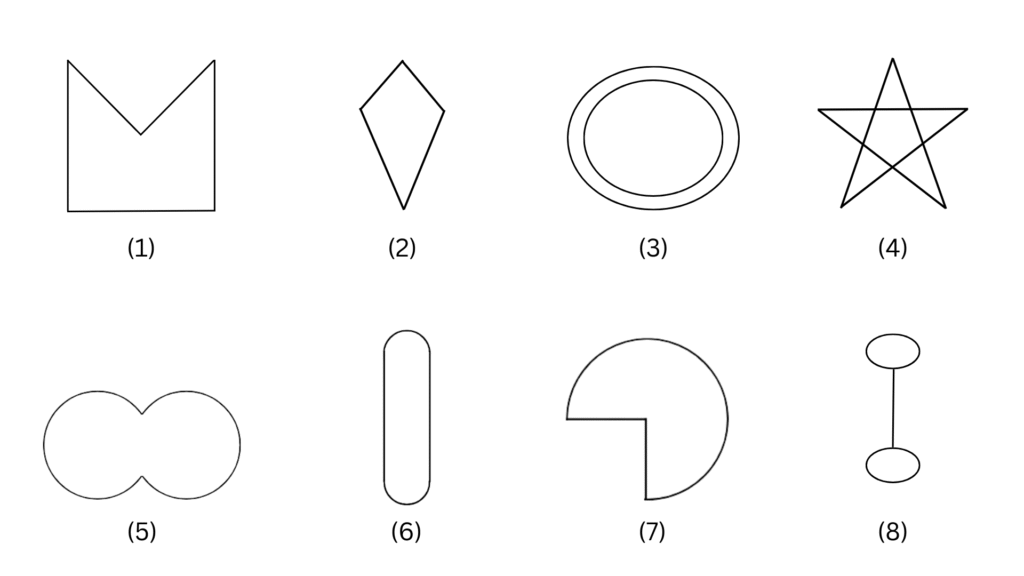
Classify each of them on the basis of the following.
(a) Simple curve (b) Simple closed curve (c) Polygon
(d) Convex polygon (e) Concave polygon
Answer:
(a) Simple curve: 1, 2, 5, 6 and 7
(b) Simple closed curve: 1, 2, 5, 6 and 7
(c) Polygon: 1 and 2
(d) Convex polygon: 2
(e) Concave polygon: 1
2. What is a regular polygon?
State the name of a regular polygon of
(i) 3 sides (ii) 4 sides (iii) 6 sides
Answer: A regular polygon has sides of equal length and angles of equal measure. A regular polygon is both ‘equilateral’ and ‘equiangular’.
(i) 3 sides
An equilateral triangle is a regular polygon with three equal sides and three equal angles.
(ii) 4 sides
A square is a regular polygon with four equal sides and four equal angles.
(iii) 6 sides
A regular hexagon has six equal sides and six equal angles.
Summary: A regular polygon has sides of equal length and angles of equal measure. A regular polygon of (i) 3 sides is an equilateral triangle, a regular polygon of (i) 4 sides is a square and a regular polygon of (i) 6 sides is a regular hexagon.
Solutions to Exercise 3.2 (Page No 24) of NCERT Class 8 Mathematics Chapter 3 Understanding Quadrilaterals:
1. Find x in the following figures.
(a)
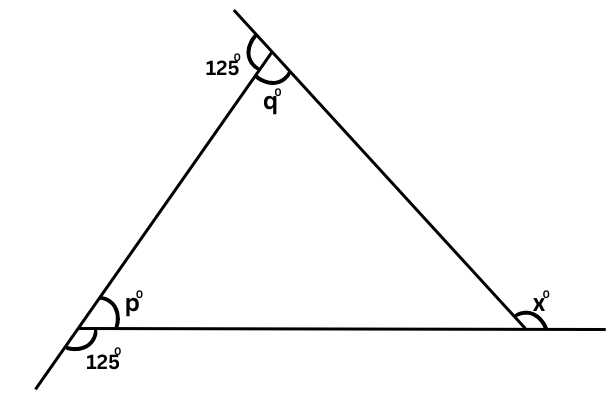
Answer:
1250 and p0 are supplementary.
Therefore, 1250 + p = 1800
or, p = 1800 – 1250 = 550
1250 and q0 are supplementary.
Therefore, 1250 + q = 1800
or, q = 1800 – 1250 = 550
x is the exterior angle of the triangle and p and q are the two interior opposite angles.
Therefore, x = p + q = 550 + 550 = 1100.
Another method:
Sum of exterior angles of a polygon = 3600.
x + 1250 + 1250 = 3600
or, x + 2500 = 3600
or, x = 3600 – 2500 = 1100.
(b)
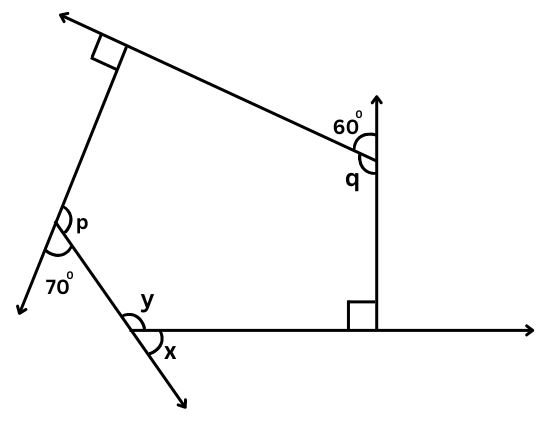
700 and p0 are supplementary.
Therefore, 700 + p = 1800
or, p = 1800 – 700 = 1100
600 and q0 are supplementary.
Therefore, 600 + q = 1800
or, q = 1800 – 600 = 1200
x0 and y0 are supplementary.
The sum of the angles of the polygon = (5 – 2) × 1800 = 5400.
Therefore,
1100 + 1200 + 900 + 900 + y = 5400
or, 4100 + y = 5400
or, y = 5400 – 4100 = 1300
x0 and y0 are supplementary.
x + y = 1800
or, x + 1300 = 1800
or, x = 1800 – 1300 = 500
Another method:
Sum of exterior angles of a polygon = 3600.
900 + 600 + 900 + 700 + x = 3600
or, 3100 + x = 3600
or, x = 3600 – 3100 = 500
Summary: In figure (a) x = 1100 and in figure (b) x = 500.
2. Find the measure of each exterior angle of a regular polygon of
(i) 9 sides (ii) 15 sides
Answers:
(i) 9 sides
Sum of the angles of a regular polygon with n sides = (n – 2) × 1800.
Therefore, the sum of the interior angles of a regular polygon with 9 sides = (9 – 2) × 1800 = 7 × 1800 = 12600.
Measure of each interior angle = 1260/9 = 1400.
Exterior and interior angles are supplementary.
Therefore,
Each exterior angle = 1800 – 1400 = 400
(ii) 15 sides
Sum of the angles of a regular polygon with n sides = (n – 2) × 1800.
Therefore, the sum of the interior angles of a regular polygon with 15 sides = (15 – 2) × 1800 = 13 × 1800 = 23400.
Measure of each interior angle = 2340/15 = 1560.
Exterior and interior angles are supplementary.
Therefore,
Each exterior angle =1800 – 1560 = 240
Summary: The measure of each exterior angle of a regular polygon of (i) 9 sides is 400 and that of a regular polygon of (ii) 15 sides is 240.
3. How many sides does a regular polygon have if the measure of an exterior angle is 24°?
Answer:
Exterior and interior angles are supplementary.
Each exterior angle = 240.
Sum of all exterior angles = 3600.
Number of sides = number of exterior angles = 360/24 = 15
Summary: If the measure of each exterior angle of a regular polygon is 240, then the number of sides = 15.
5. (a) Is it possible to have a regular polygon with measure of each exterior angle as 22°?
(b) Can it be an interior angle of a regular polygon? Why?
Answers:
(a) Exterior and interior angles are supplementary.
Each exterior angle = 220.
Sum of all exterior angles = 3600.
Number of sides = number of exterior angles = 360/22 = 16.36.
The number of sides has to be an integer, hence such a regular polygon cannot exist.
(b) Each interior angle = 220.
Sum of all interior angles = 3600.
Number of sides = number of interior angles = 360/22 = 16.36.
The number of sides has to be an integer, hence such a regular polygon cannot exist.
Summary: It is not possible to have a regular polygon with measure of each exterior angle or each interior angle as 22°. This is because the number of sides in these cases is a decimal value, which is not possible.
6. (a) What is the minimum interior angle possible for a regular polygon? Why?
(b) What is the maximum exterior angle possible for a regular polygon?
Answers:
(a)The regular polygon with the minimum number of sides will have the minimum possible interior angle. This is an equilateral triangle.
Therefore, the minimum interior angle = 180/3 = 600.
As the number of sides increases in a regular polygon, the value of the interior angles also increases.
(b) We know that interior angles and exterior angles are supplementary because they form a linear pair.
Exterior angle = 1800 – interior angle.
Therefore, exterior angle is maximum when interior angle is minimum.
Since we found in (a) that an equilateral triangle has the minimum interior angle, it will also have the maximum exterior angle.
Therefore, maximum exterior angle = 1800 – 600 = 1200.
Summary: (a) The minimum interior angle possible for a regular polygon is 600 and (b) the maximum exterior angle possible for a regular polygon is 1200. Both are for an equilateral triangle.
Solutions to Exercise 3.3 (Page No 30) of NCERT Class 8 Mathematics Chapter 3 Understanding Quadrilaterals:
1. Given a parallelogram ABCD. Complete each statement along with the definition or property used.

(i) AD = _________ (ii) ∠DCB = _________
(iii) OC = _________ (iv) m ∠DAB + m ∠CDA = _________
Answers:
(i) AD = BC (Opposite sides of a parallelogram are equal)
(ii) ∠DCB = ∠DAB (Opposite angles of a parallelogram are equal)
(iii) OC = OA (Diagonals of a parallelogram bisect each other)
(iv) m ∠DAB + m ∠CDA = 1800 (The adjacent angles in a parallelogram are supplementary)
2. Consider the following parallelograms. Find the values of the unknown x, y, z.
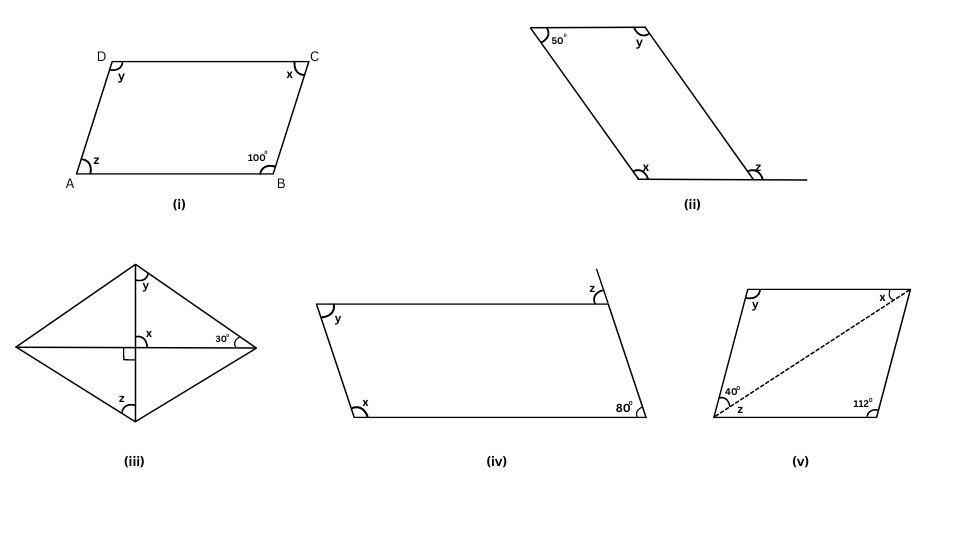
Answers:
(i) The figure is shown below:
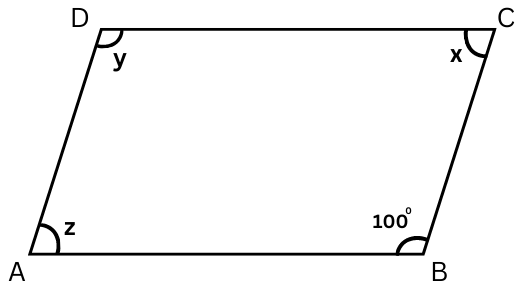
z + 1000 = 1800 (The adjacent angles in a parallelogram are supplementary)
or, z = 1800 – 1000
or, z = 800
Now, y = 1000 (Opposite angles of a parallelogram are equal)
Also, x = z = 800 (Opposite angles of a parallelogram are equal)
Summary: x = 800, y = 1000 and z = 800.
(ii) The figure is shown below:
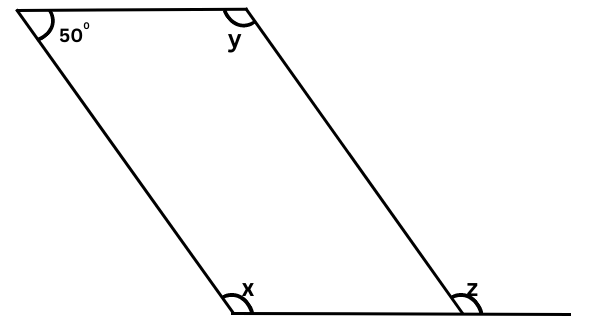
500 + x = 1800 (The adjacent angles in a parallelogram are supplementary)
or, x = 1800 – 500
or, x = 1300
Now, y = x = 1300 (Opposite angles of a parallelogram are equal)
Also, z = x = 1300 (Equal corresponding angles because the opposite sides of the parallelogram are parallel)
Summary: x = 1300, y = 1300, z = 1300.
(iii) The figure is shown below:
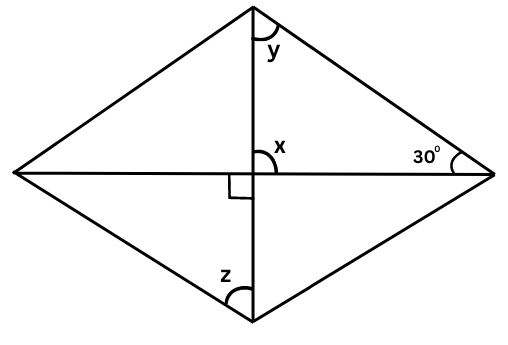
x = 900 (Vertically opposite angles)
Now, x + y + 300 = 1800 (Sum of angles of a triangle = 1800)
or, 900 + y + 300 = 1800
or, y = 1800 – 1200 = 600
Also, z = y = 600 (Equal alternate angles because the opposite sides of the parallelogram are parallel)
Summary: x = 900, y = 600, z = 600.
(iv) The figure is shown below:
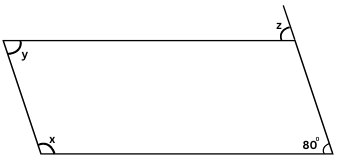
y = 800 (Vertically opposite angles)
z = y = 800 (Equal alternate angles because the opposite sides of the parallelogram are parallel)
x + y = 1800 (The adjacent angles in a parallelogram are supplementary)
or, x + 800 = 1800
or, x = 1800 – 800 = 1000
Summary: x = 1000, y = 800, z = 800.
(v) The figure is shown below:
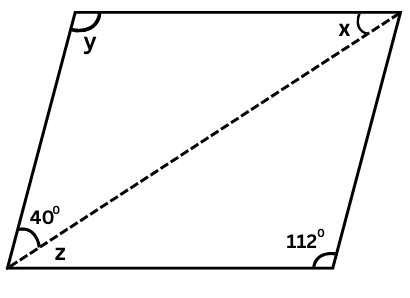
y = 1120 (Vertically opposite angles)
400 + z + 1120 = 1800 (The adjacent angles in a parallelogram are supplementary)
or, z + 1520 = 1800
or, z = 1800 – 1520 = 280
x = z = 280 (Equal alternate angles because the opposite sides of the parallelogram are parallel)
Summary: x = 280, y = 1120, z = 280.
3. Can a quadrilateral ABCD be a parallelogram if
(i) ∠D + ∠B = 180°? (ii) AB = DC = 8 cm, AD = 4 cm and BC = 4.4 cm?
(iii) ∠A = 70° and ∠C = 65°?
Answers:
(i) ∠D + ∠B = 180°?
Quadrilateral ABCD is a parallelogram if opposite angles are equal and sum of adjacent angles are equal = 1800.
Here ∠D and ∠B are opposite angles in a parallelogram, so they have to be equal.
Since ∠D + ∠B = 180°, ∠D = ∠B = 900
It is easy to see that ∠A and ∠C are both = 900.
This gives us a rectangle.
Therefore, there may or may not be a parallelogram for the given condition. If there is a parallelogram it has to be a rectangle.
(ii) AB = DC = 8 cm, AD = 4 cm and BC = 4.4 cm?
In a parallelogram opposite sides are equal. In this quadrilateral ABCD, AB = DC = 8 cm which satisfies the condition. But, AD = 4 cm and BC = 4.4 cm are not equal which does not satisfy the above condition. Therefore, in this case quadrilateral ABCD cannot be a parallelogram.
(iii) ∠A = 70° and ∠C = 65°?
In a parallelogram opposite angles are equal. ∠A = 70° and ∠C = 650, which does not satisfy the above condition. Therefore, in this case quadrilateral ABCD cannot be a parallelogram.
Summary: For quadrilateral ABCD: if (i) ∠D + ∠B = 180°, there may or may not be a parallelogram. If there is a parallelogram it has to be a rectangle. If (ii) AB = DC = 8 cm, AD = 4 cm and BC = 4.4 cm, quadrilateral ABCD cannot be a parallelogram. If (iii) ∠A = 70° and ∠C = 65°, quadrilateral ABCD cannot be a parallelogram.
4. Draw a rough figure of a quadrilateral that is not a parallelogram but has exactly two opposite angles of equal measure.
Answer:
The following quadrilateral ABCD has opposite angles ∠A and ∠C of equal measure, but is not a quadrilateral.
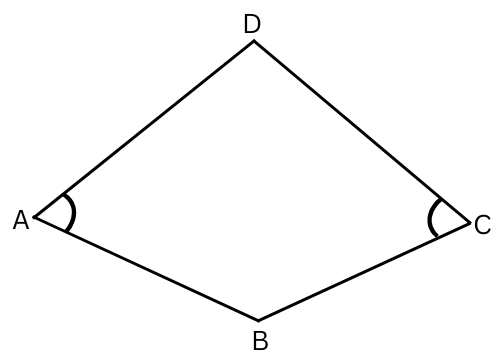
5. The measures of two adjacent angles of a parallelogram are in the ratio 3 : 2. Find the measure of each of the angles of the parallelogram.
Answer:
Let the two adjacent angles of a parallelogram be 3x and 2x.
The adjacent angles in a parallelogram are supplementary.
So, 3x + 2x = 1800
or, 5x = 1800
or, x = 180/5 = 360
Then 3x = 1080 and 2x = 720.
Opposite angles of a parallelogram are equal.
Therefore, the angle opposite to 3x = 1080 and the angle opposite to 2x = 720.
Summary: The measures of the four angles of the parallelogram are 1080, 720, 1080 and 720.
6. Two adjacent angles of a parallelogram have equal measure. Find the measure of each of the angles of the parallelogram.
Answer:
Let the measure of each adjacent angle be x.
The adjacent angles in a parallelogram are supplementary.
x + x = 1800
or, 2x = 1800
or, x = 180/2 = 900
Opposite angles of a parallelogram are equal.
Therefore, the other two angles also = 900.
Summary: Therefore, the measure of each angle of the parallelogram = 900. This suggests that the parallelogram is a rectangle or a square.
7. The adjacent figure HOPE is a parallelogram. Find the angle measures x, y and z. State the properties you use to find them.
Answer:
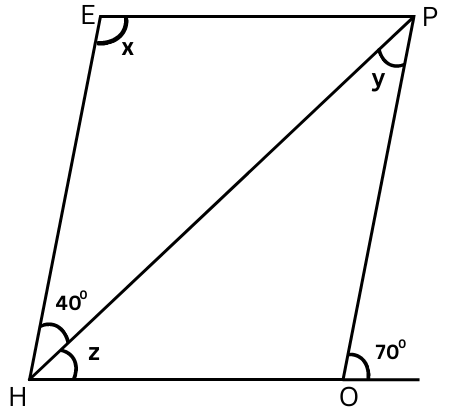
Answer:
In parallelogram HOPE,
∠H = ∠O = 700 (Corresponding angles because HE ∥ OP)
z + 400 = 700
or, z = 700 – 400 = 300
∠H + ∠E = 1800 (The adjacent angles in a parallelogram are supplementary)
or, 700 + x = 1800
or, x = 1800 – 700 = 1100
Also, y = 400 (Alternate angles are equal)
Summary: In parallelogram HOPE, x = 1100, y = 400 and z = 300.
8. The following figures GUNS and RUNS are parallelograms. Find x and y. (Lengths are in cm)

Answers:
(i) In parallelogram GUNS opposite sides are parallel.
Therefore,
3x = 18 or x = 18/3 = 6
and, 3y – 1 = 26
or, 3y = 26 + 1
or, 3y = 27
or y = 27/3 = 9
In parallelogram GUNS, x = 6 and y = 9.
(ii) In parallelogram RUNS, the diagonals bisect each other.
Therefore,
y + 7 = 20 or, y = 20 – 7 = 13
Also, x + y = 16
or, x + 13 = 16
or, x = 16 – 13 = 3
In parallelogram RUNS, x = 3 and y = 13.
Summary: (i) In parallelogram GUNS, x = 6 and y = 9. (ii) In parallelogram RUNS, x = 3 and y = 13.
9. In the above figure both RISK and CLUE are parallelograms. Find the value of x.

Answer:
In parallelogram RISK,
∠K + ∠ISK = 1800 (Adjacent angles in a parallelogram are supplementary)
or, 1200 + ∠ISK = 1800
or, ∠ISK = 1800 – 1200
or, ∠ISK = 600
In parallelogram CLUE,
∠CEU = ∠L (Opposite angles in a parallelogram are equal)
or, ∠CEU = 700
In △EOS sum of all three angles = 1800.
Therefore,
x + 600 + 700 = 1800
or, x + 1300 = 1800
or, x = 1800 – 1300
or, x = 500
Summary: The value of x = 500. We used the properties that adjacent angles in a parallelogram are supplementary, opposite angles in a parallelogram are equal and sum of all three angles in a triangle = 1800.
10. Explain how this figure is a trapezium. Which of its two sides are parallel? (Fig 3.32)
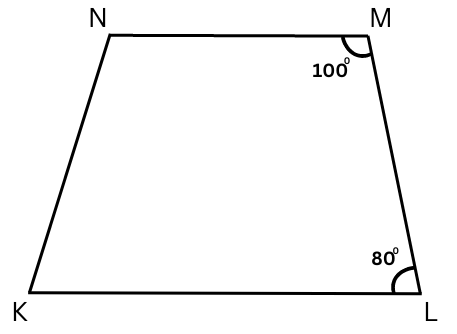
Answer: ∠L and ∠M are adjacent interior angles, ML is the transversal and ∠L + ∠M = 800 + 1000 = 1800. Therefore, we can say that NM ∥ KL. The other two sides are not parallel. Hence, we can say that in the figure only one pair of sides are parallel and it is a trapezium.
11. Find m∠C in Fig 3.33 if AB ∥ DC.
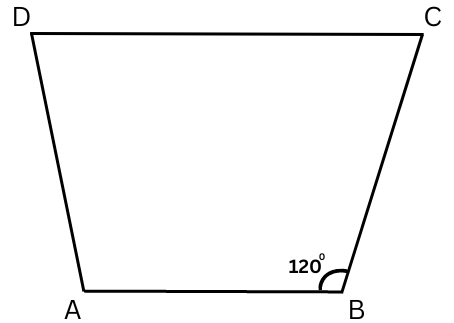
Answer: If AB ∥ DC, and ∠B + ∠C = 1800 because they are adjacent interior angles. So, 1200 + ∠C = 1800 or m∠C = 1800 – 1200 = 600.
12. Find the measure of ∠P and ∠S if SP ∥ RQ in Fig 3.34. (If you find m∠R, is there more than one method to find m∠P?)
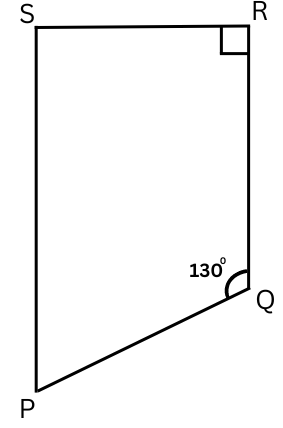
Answer:
Since SP ∥ RQ , we have:
∠P + ∠Q = 1800
or ∠P = 1800 – 1300
or ∠P = 500.
We also have ∠S + ∠R = 1800
or ∠S = 1800 – 900
or ∠S = 900.
Alternative Method: The sum of all interior angles in a quadrilateral = 3600.
Therefore,
∠P + ∠Q + ∠S + ∠R = 3600
or, ∠P + 1300 + 900 + 900 = 3600
or, ∠P + 3100 = 3600
or, ∠P = 3600 – 3100
or, ∠P = 500
Summary: The measure of ∠P = 500 and measure of ∠S = 900. You can use the alternate method that the sum of all interior angles in a quadrilateral = 3600 to find the magnitude of ∠P = 500.
Solutions to Exercise 3.4 (Page No 35) of NCERT Class 8 Math Chapter 3 Understanding Quadrilaterals –
1. State whether True or False.
(a) All rectangles are squares.
Answer: False. Only a specific kind of rectangle where all sides are equal is called a square. Hence, all rectangles are not squares.
(b) All rhombuses are parallelograms.
Answer: True. A rhombus is a special case of a parallelogram with all sides equal. Therefore, all rhombuses are parallelograms.
(c) All squares are rhombuses and also rectangles.
Answer: True. A square is a specific kind of rhombus with each interior angle = 900. Hence, all squares are rhombuses. A square is a specific kind of rectangle with all sides equal. Hence, all squares are rectangles.
(d) All squares are not parallelograms.
Answer: False. A square is a specific type of parallelogram with all sides equal. Hence, all squares are parallelograms.
(e) All kites are rhombuses.
Answer: False. A kite becomes a rhombus only when all sides are equal. Hence, all kites are not rhombuses.
(f) All rhombuses are kites.
Answer: True. A rhombus is a specific type of kite in which all sides equal and diagonals bisect each other. Hence, all rhombuses are kites.
(g) All parallelograms are trapeziums.
Answer: False. Parallelograms have both pairs of opposite sides parallel. A trapezium has only one pair of opposite sides parallel. Hence, all parallelograms are not trapeziums.
(h) All squares are trapeziums.
Answer: False. Squares have opposite sides parallel and all sides equal. A trapezium has only one pair of opposite sides parallel. Hence, all squares are not trapeziums.
2. Identify all the quadrilaterals that have.
(a) four sides of equal length (b) four right angles
Answers:
(a) Rhombus and square have four sides of equal length.
(b) Square and rectangle have four right angles.
3. Explain how a square is
(i) a quadrilateral (ii) a parallelogram (iii) a rhombus (iv) a rectangle
Answers:
(i) a quadrilateral: A square isa quadrilateral because it has four sides.
(ii) a parallelogram: A square is a parallelogram because the opposite sides are parallel.
(iii) a rhombus: A square is a rhombus because all sides are equal and diagonals are perpendicular bisectors of each other.
(iv) a rectangle: A square is a rectangle because all interior angles are = 900 and opposite sides are equal.
Summary: A square is (i) a quadrilateral because it has four sides.(ii) a parallelogram because opposite sides are parallel.(iii) a rhombus because all sides are equal and diagonals are perpendicular bisectors of each other. (iv) a rectangle because all interior angles are = 900 and opposite sides are equal.
4. Name the quadrilaterals whose diagonals.
(i) bisect each other (ii) are perpendicular bisectors of each other (iii) are equal
Answer:
(i) bisect each other: The diagonals of a parallelogram, rhombus, rectangle and square bisect each other.
(ii) are perpendicular bisectors of each other: Rhombus and square.
(iii) are equal: The diagonals of a rectangle and square are equal.
5. Explain why a rectangle is a convex quadrilateral.
Answer: A rectangle is a convex quadrilateral because both the diagonals lie in the interior. Also in a rectangle, all four interior angles are = 900. Since all angles in a rectangle are less than 1800, it satisfies the condition of a convex quadrilateral.
6. ABC is a right-angled triangle and O is the mid-point of the side opposite to the right angle. Explain why O is equidistant from A, B and C. (The dotted lines are drawn additionally to help you).
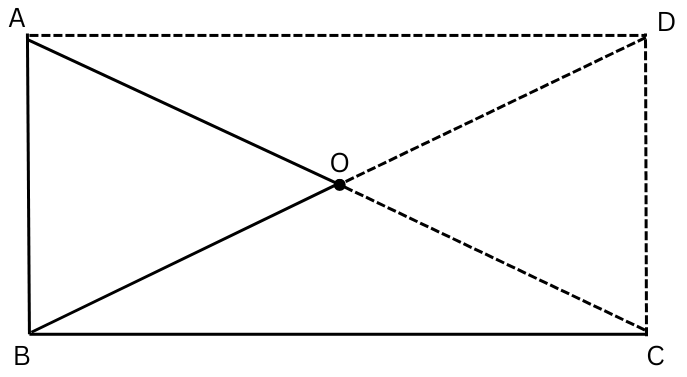
Answer:
AD and DC are drawn so that AB || DC and AD || BC and AB = DC and AD = BC.
Hence, ∠B = ∠C = ∠D = ∠A = 900.
Therefore, ABCD is a rectangle as opposite sides are equal and parallel to each other and all the interior angles are 90°.
The diagonals of a rectangle are equal and bisect each other.
Therefore,
AC = BD and AO = OC = BO = OD.
Hence, it is proved O is equidistant from A, B and C.
Summary: ABC is a right-angled triangle and O is the mid-point of the side opposite to the right angle.O is equidistant from A, B and C because O is the point of intersection of the diagonals of the rectangle ABCD. The diagonals are equal and bisect each other and so AO = OC = BO.
Important Questions from Previous NCERT Textbook:
Exercise 3.1 Page No: 41 (Old Textbook):
2. How many diagonals does each of the following have?
(a) A convex quadrilateral (b) A regular hexagon (c) A triangle
Answers:
(a) A convex quadrilateral has 2 diagonals. (b) A regular hexagon has 9 diagonals. (c) A triangle has 0 diagonals.
3. What is the sum of the measures of the angles of a convex quadrilateral? Will this property hold if the quadrilateral is not convex? (Make a non-convex quadrilateral and try!)
Answer: Look at the convex quadrilateral ABCD below:
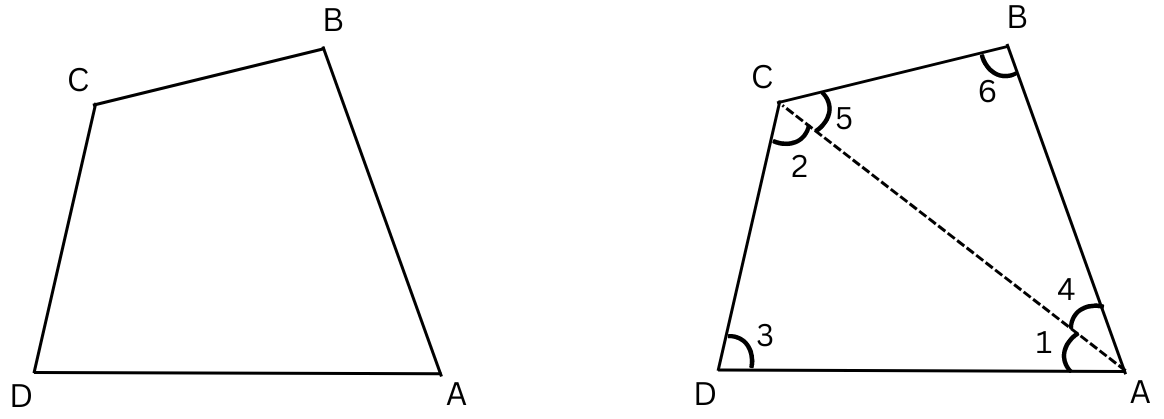
Join AC in ABCD.
ABCD = ΔADC + ΔABC
In ΔADC, ∠1 + ∠2 + ∠3 = 1800 and in ΔABC, ∠4 + ∠5 + ∠6 = 1800.
Therefore, in ABCD sum of angles = ∠1 + ∠2 + ∠3 + ∠4 + ∠5 + ∠6 = 1800 + 1800= 3600.
Look at the concave quadrilateral ABCD below:

Join BD in ABCD,
ABCD = ΔBDA + ΔBDC
In ΔBDC, ∠1 + ∠2 + ∠3 = 1800 and in ΔBDA, ∠4 + ∠5 + ∠6 = 1800.
Therefore, in ABCD sum of angles = ∠1 + ∠2 + ∠3 + ∠4 + ∠5 + ∠6 = 1800 + 1800= 3600.
Summary: The sum of the measures of the angles of a convex quadrilateral = 3600 and the sum of the measures of the angles of a non-convex quadrilateral also = 3600. This property holds for any quadrilateral because any quadrilateral can be divided into two triangles, each having sum of angles = 1800.
4. Examine the table. (Each figure is divided into triangles and the sum of the angles deduced from that.)

What can you say about the angle sum of a convex polygon with number of sides?
(a) 7 (b) 8 (c) 10 (d) n
Answers:
From the information give in the above table we can develop a formulae for the angle sum of a polygon with n sides:
Angle sum of a polygon with n sides = (n – 2) × 1800
(a) 7
For n = 7, angle sum = (7 – 2) × 1800 = 5 × 1800 = 9000.
(b) 8
For n = 8, angle sum = (8 – 2) × 1800 = 6 × 1800 = 10800.
(c) 10
For n = 10, angle sum = (10 – 2) × 1800 = 8 × 1800 = 14400.
(d) n
For n sides, angle sum = (n – 2) × 1800
Summary: The formulae for angle sum of a polygon with n sides = (n – 2) × 1800. Therefore: (a) For n = 7, angle sum = 9000, (b) for n = 8, angle sum = 10800, (c) for n = 10, angle sum = 14400 and (d) for n sides, angle sum = (n – 2) × 1800.
6. Find the angle measure of x in the following figures.
(a) The figure is shown below:
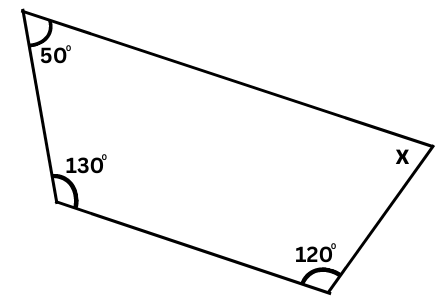
The figure has four sides, hence it is a quadrilateral.
Sum of all angles in a quadrilateral = 3600.
Therefore,
x + 500 + 1300 + 1200 = 3600
or, x + 3000 = 3600
or, x = 3600 – 3000
or, x = 600 (Answer)
(b) The figure is shown below:
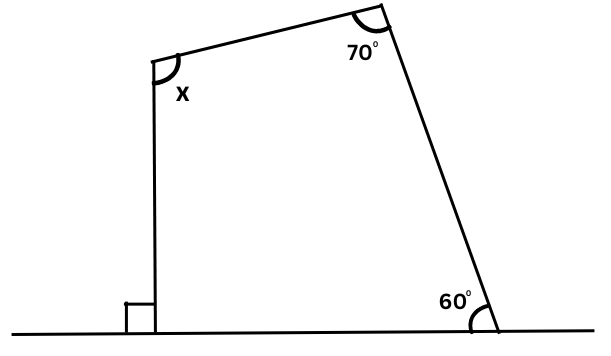
The figure has four sides, hence it is a quadrilateral.
Sum of all angles in a quadrilateral = 3600.
One angle = 900.
Therefore,
900 + x + 700 + 600 = 3600
or, x + 2200 = 3600
or, x = 3600 – 2200
or, x = 1400 (Answer)
(c) The figure is shown below:
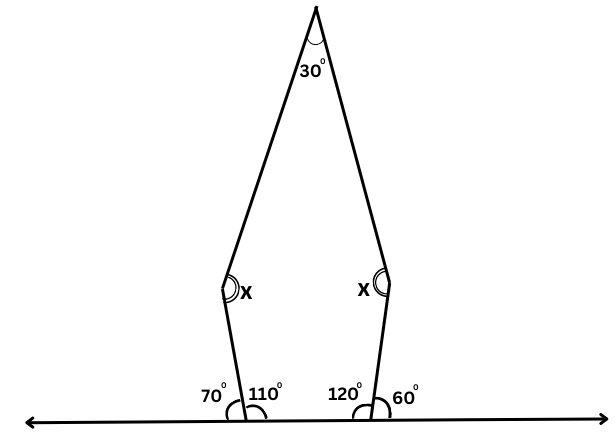
The figure has five sides, hence it is a pentagon.
The 700 angle and the adjacent angle inside the polygon are supplementary.
So, 1800 – 700 = 1100
The 600 angle and the adjacent angle inside the polygon are supplementary.
So, 1800 – 600 = 1200
Angle sum of a polygon with n sides = (n – 2) × 1800.
For a polygon with 5 sides = (5 – 2) × 1800 = 3 × 1800 = 5400.
Therefore,
1100 + 1200 + x + x + 300 = 5400
or, 2600 + 2x = 5400
or, 2x = 5400 – 2600
or, 2x = 2800
or, x = 280/2
or, x = 1400 (Answer)
(d) The figure is shown below:
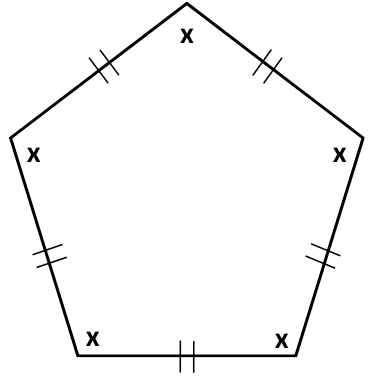
The figure has five sides, hence it is a pentagon.
Angle sum of a polygon with n sides = (n – 2) × 1800.
For a polygon with 5 sides = (5 – 2) × 1800 = 3 × 1800 = 5400.
Therefore,
x + x + x + x + x = 5400
or, 5x = 5400
or, x = 540/5
or, x = 1080 (Answer)
Summary: For figure (a) the value of x = 600, for figure (b) the value of x = 1400, for figure (c) the value = 1400 and for figure (d) the value of x = 1080.
7. (a)
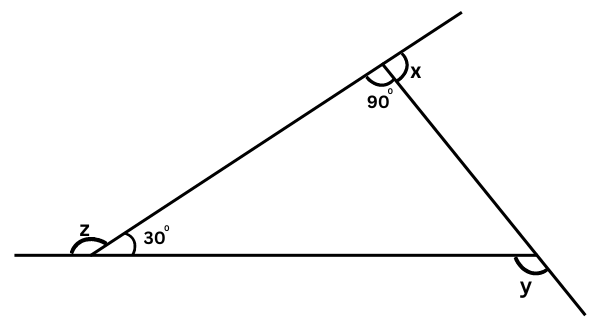
Find x + y + z
Answer:
(a) The angles z and 300 are supplementary.
z + 300 = 1800
or, z = 1800 – 300 = 1500
The angles x and 900 are supplementary.
x + 900 = 1800
or, x = 1800 – 900 = 900
y is the exterior angle of the triangle and 300 and 900 are the two interior opposite angles.
y = 300 + 900 = 1200
x + y + z = 900 + 1200 + 1500 = 3600
(b)
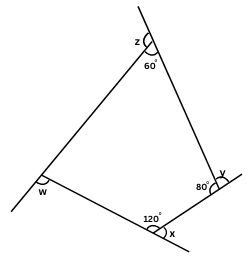
Find x + y + z + w
Answer:
The figure has four sides, hence it is a quadrilateral.
Sum of all angles in a quadrilateral = 3600.
Unknown fourth angle = 3600 – 1200 – 800 – 600 = 1000
z and 600 are supplementary.
z + 600 = 1800
or, z = 1800 – 600 = 1200
y and 800 are supplementary.
y + 800 = 1800
or, y = 1800 – 800 = 1000
x and 1200 are supplementary.
x + 1200 = 1800
or, x = 1800 – 1200 = 600
w and 1000 are supplementary.
w + 1000 = 1800
or, w = 1800 – 1000 = 800
Therefore, x + y + z + w = 600 + 1000 + 1200 + 800 = 3600.
Summary: The values of (a) x + y + z = 3600 and (b) x + y + z + w = 3600.
Extra Questions to Complement Solutions to NCERT Class 8 Mathematics Chapter 3 Understanding Quadrilaterals:
Very Short Answer Type Questions:
1. The diagonals of a parallelogram bisect each other but are not equal. Which specific types of parallelograms can you rule out based on this condition?
Answer:
You can rule out square, rectangle and rhombus. The diagonals in a square, rectangle or rhombus are equal and bisect each other.
2. You are given star-shaped polygon. What kind of polygon is it?
Answer:
The star-shaped polygon is a concave polygon.
3. Calculate the sum of interior angles in a hexagon.
Answer:
The sum of interior angles for a polygon of n sides = (n – 2) × 1800. Therefore, the sum of interior angles in a hexagon = (6 – 2) × 1800 = 4 × 1800 = 7200.
4. Are the measures of the exterior angles in a regular hexagon equal? Why?
Answer:
In a regular hexagon the measure of interior angles are equal. Since interior angle + exterior angle = 1800, all the exterior angles are also equal.
5. Name a quadrilateral that has one line of symmetry.
Answer:
The kite is a quadrilateral that has one line of symmetry.
6. Given the length of one side of a parallelogram = 5 cm can you find the length of all sides?
Answer:
No. In a parallelogram only opposite sides are equal.If we are given the length of one side = 5 cm, we can only find the length of the opposite side. You cannot find the length of the other two sides.
7. Name the quadrilaterals whose diagonals are equal in length and bisect each other.
Answer:
Square and rectangle are the quadrilaterals whose diagonals are equal in length and bisect each other.
8. Only three sides of a quadrilateral are equal. The length of the fourth side is known. Is it a square?
Answer:
It may not be a square. The interior angles of the quadrilateral may not be 900, in which case it will not be a square.
9. Explain why the sum of interior angles in any quadrilateral is always 3600.
Answer:
Any quadrilateral can be divided into two triangles by drawing a diagonal. Sum of the angles of each triangle = 1800. Sum of the angles of both triangles which make up the quadrilateral = 1800 + 1800 = 3600.
10. Name the quadrilaterals which have a line of symmetry along a diagonal.
Answer:
Rhombus, square and kite are the quadrilaterals which have a line of symmetry along a diagonal. Rhombus and square are symmetric about both diagonals. Kite is symmetric about one diagonal.
Multiple Choice Questions (MCQ):
1. What can you say about the diagonals in a kite:
(a) They bisect each other.
(b) Only one of diagonals bisects the other.
(c) The diagonals do not bisect each other
(d) Whether the diagonals bisect each other depends on the length of the sides of the kite.
Answer: Correct answer: (b) Only one of diagonals bisects the other.
2. The diagonals of a parallelogram:
(a) Bisect each other at right angles.
(b) Bisect each other and are equal.
(c) Do not bisect each other.
(d) Bisect each other and are not equal.
Answer: Correct answer: (d) Bisect each other and are not equal.
3. The perimeter of a rhombus is 40 cm. Is it possible to find the length of each side?
(a) Yes it is possible.
(b) No you need extra information.
(c) It is possible for this rhombus, but not for other rhombuses.
(d) It is not possible for this rhombus, but might be possible for other rhombuses.
Answer: Correct answer:(a) Yes it is possible.
All sides in a rhombus are equal. Therefore, each side = 40/4 = 10 cm.
4. A diagonal of a square is drawn. The resulting two triangles:
(a) Are congruent
(b) Have equal area
(c) Are both congruent and have equal area
(d) None of the above
Answer: Correct answer: (c) Are both congruent and have equal area.
5. A trapezium has:
(a) One pair of parallel sides.
(b) One pair of parallel lines and two equal sides.
(c) Two pairs of parallel sides.
(d) One pair of parallel lines and two pairs of equal sides
Answer: Correct answer:(a) One pair of parallel lines.
Short and Long Answer Type Questions:
1. Find the measure of x in the following figure:
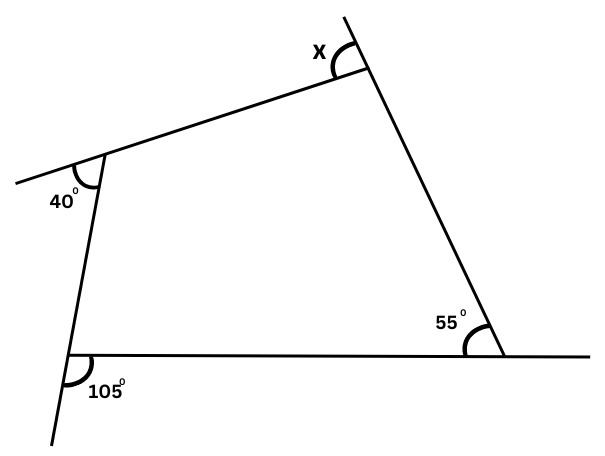
Answer: The figure is shown below:
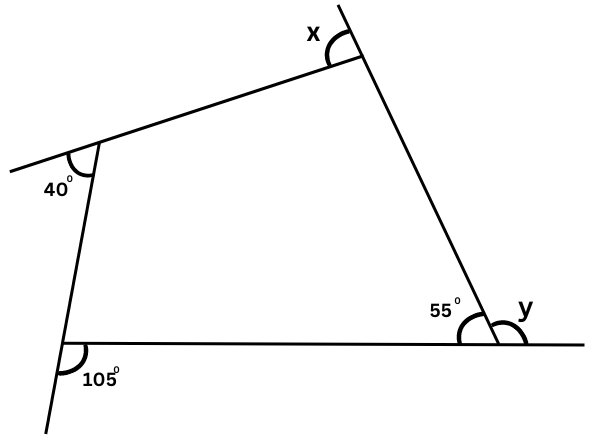
Interior and exterior angles form a supplementary pair.
y + 550 = 1800
or, y = 1800 – 550 = 1250
Sum of all the measures of external angles in a polygon = 3600.
Therefore,
1050 + 400 + 1250 + x = 3600
or, 2700 + x = 3600
or, x = 3600 – 2700
or, x = 900 (Answer)
2. What is the value of x in the kite below? Given: ∠ABD = 450.
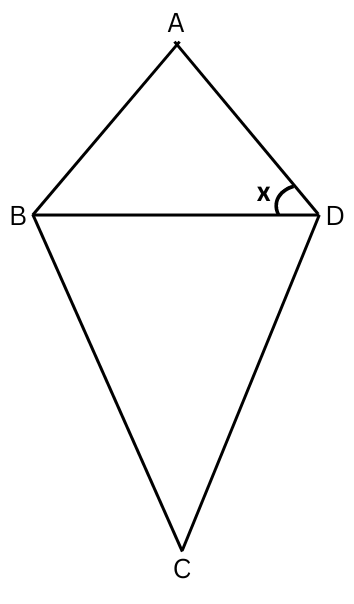
Answer:
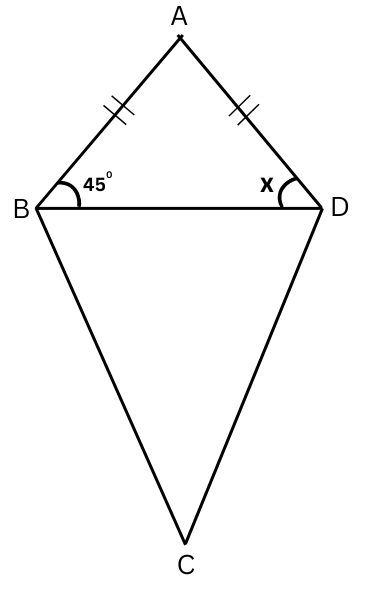
In △ABD, ∠ABD = 450.
Since ABCD is a kite, AB = AD.
Therefore, ∠ABD = ∠ADB (△ABD is isosceles triangle) or, x = ∠ADB = 450.
3. Find the value of x in parallelogram ABCD.
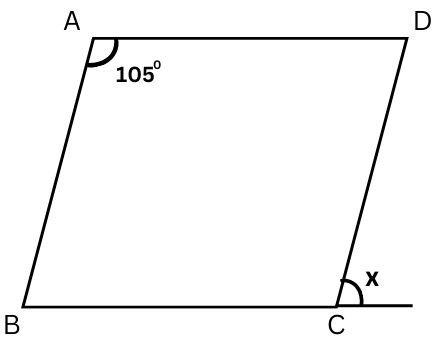
Answer:
Given: ∠BAD = 1050.
Opposite angles in a parallelogram are equal.
Therefore, ∠BCD = 1050.
Interior and exterior angles are supplementary.
∠BCD + x = 1800.
or, 1050 + x = 1800
or, x = 1800 – 1050
or, x = 750 (Answer)
4. In parallelogram ABCD, the length of side AB is 10 cm, and the length of side BC is 12 cm. If the measure of ∠B is 650, find the length of side AD and the measure of angles A, C, and D.
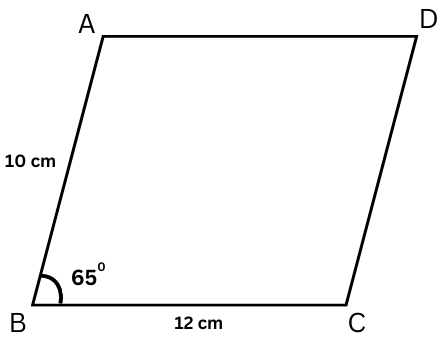
Answer:
Opposite sides in a parallelogram are equal.
Therefore, AD = BC = 12 cm.
The adjacent interior angles in a parallelogram are supplementary.
Therefore,
∠A + ∠B = 1800
or, ∠A + 650 = 1800
or, ∠A = 1800 – 650
or, ∠A = 1150
Opposite angles in a parallelogram are equal.
Therefore,
∠D = ∠B = 650.
and ∠C = ∠A = 1150
5. Find the length of the diagonal of a square of side 5 cm.
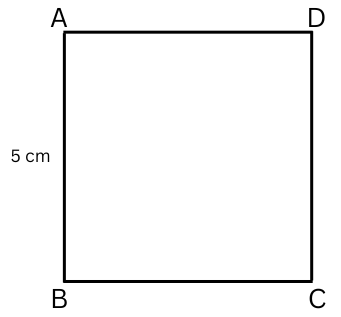
Answer: The angles of a square are all = 900 and all sides are equal.
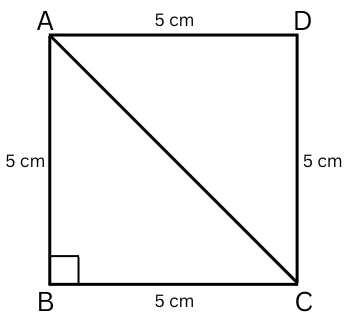
Therefore, using Pythagoras’ theorem:
AB2 + BC2 = AC2
or, AC2 = AB2 + BC2
or, AC2 = 52 + 52
or, AC2 = 25 + 25
or, AC2 = 50
or AC = 7.07 (Answer)
6. The perimeter of a parallelogram is 36 cm, and the length of one side is 8 cm. Find the length of the other side.
Answer: Let the other side be x.
Opposite sides in a parallelogram are equal.
Perimeter of a rectangle = sum of all four sides.
Therefore,
2(x + 8) = 36
or, 2x + 16 = 36
or, 2x = 36 – 16
or, 2x = 20
or, x = 10
Therefore, the length of the other side = 10 cm.
7. Calculate the length of diagonal BD of a rhombus with one side = 5 cm and diagonal AC = 6 cm.

Answer: The figure is shown below:
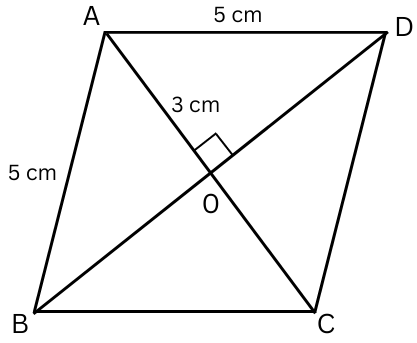
All sides of the rhombus are equal = 5 cm.
The diagonals bisect each other at 900.
Therefore,
AO = OC = AC/2 = 6/2 = 3 cm.
Therefore, in △ AOD using Pythagoras Theorem:
AO2 + OD2 = AD2
or, 32 + OD2 = 52
or, OD2 = 25 – 9
or, OD2 = 16
or, OD = √16
or, OD = 4 cm
Therefore,
BD = 2OD = 8 cm. (since diagonals bisect each other)
Therefore, length of diagonal BD = 8 cm.
8. Look at the rectangle ABCD below. Can you find ∠BOC?
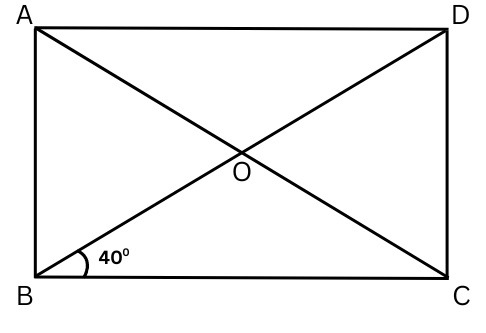
Answer: The figure is shown below:
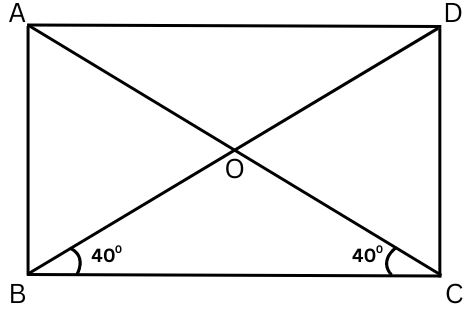
In a rectangle, diagonals are equal.
Therefore, AC = BD.
In a rectangle, diagonals bisect each other.
Therefore, BO = CO and △ BOC is an isosceles triangle.
Therefore, ∠OCB = ∠OBC = 400.
In △ BOC sum of all angles = 1800.
∠BOC + ∠OCB + ∠OBC = 1800
or, ∠BOC + 400 + 400 = 1800
or, ∠BOC = 1800 – 800
or, ∠BOC = 1000 (Answer)
9. Look at the parallelogram ABCD below. Can you find ∠BOC?
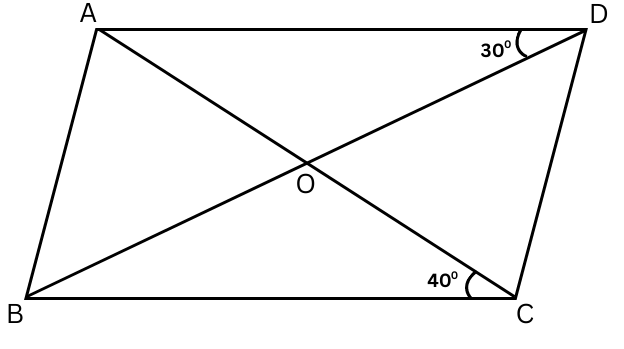
Answer:
In a parallelogram opposite sides are parallel.
Therefore, AD || BC and ∠ADB = ∠DBC = 300 (alternate angles are equal)
In △ BOC sum of all angles = 1800.
∠BOC + ∠OCB + ∠OBC = 1800
or, ∠BOC + 400 + 300 = 1800
or, ∠BOC = 1800 – 700
or, ∠BOC = 1100 (Answer)
10. Take a parallelogram ABCD in which ∠ABC = 1200. Extend the lines BA and CD. Then take any two points P and Q on BA extended and CD extended respectively. Join PQ. ∠QPA = 600. Is DAPQ a parallelogram?
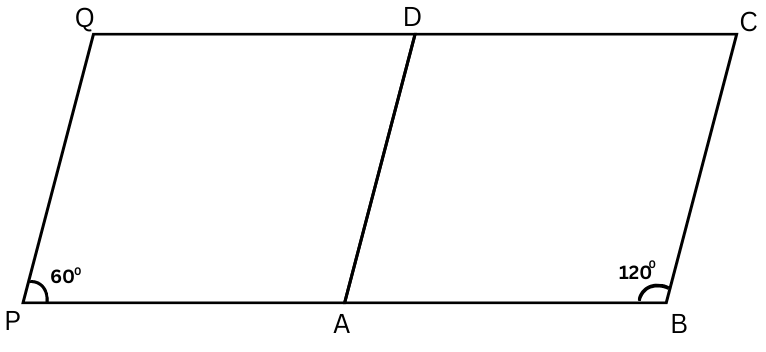
Answer:
In a parallelogram opposite sides are parallel.
Therefore, AD || BC and ∠DAB + ∠ABC = 1800 (sum of adjacent opposite angles = 1800)
or, ∠DAB + 1200 = 1800
or, ∠DAB = 1800 – 1200 = 600
Now, ∠DAB = 600 and ∠QPA = 600 and PB is a transversal.
Therefore, we can say that PQ || AD. Also PA || QD because they are formed by extending the parallel lines BA and CD.
Hence it is proved that DAPQ is a parallelogram.
Fill in the Blanks:
(a) __________ is a polygon with 8 sides.
(b) In a convex polygon, all interior angles are __________ 1800.
(c) A __________ is a simple closed curve with 7 sides.
(d) A kite is a type of _________.
(e) The diagonals of a rhombus bisect each other at __________ angles.
Answers:
(a) Octagon is a polygon with 8 sides.
(b) In a convex polygon, all interior angles are less than 1800.
(c) A heptagon is a simple closed curve with 7 sides.
(d) A kite is a type of quadrilateral.
(e) The diagonals of a rhombus bisect each other at right angles.
++++++++++++++
Frequently Asked Questions (FAQs) on NCERT Solutions to Class 8 Mathematics Chapter 3 Understanding Quadrilaterals:
Our team of Indian and foreign-educated scientists and engineers have intricately designed these solutions to teach you the geometry problem-solving techniques. You will learn all the problem-solving strategies you need to know if you go through the textbook exercise solutions and the extra questions. We advise that you draw out the figures and solve the problems by yourself alongside studying the solutions. This approach is very effective when it comes to learning geometry problem-solving.
The PDF version of the solutions is also available for download anytime for free! We are committed to helping students and will be sending you lots more useful study material. So subscribe to our email list with one click and be among the first to receive them.
The following topics are covered:
3.1 – Introduction
3.2 – Sum of the Measures of the Exterior Angles of a Polygon
3.3 – Kinds of Quadrilaterals
3.4 – Some Special Parallelograms
Here are the number of problems for the chapter:
Exercise 3.1 – 2 Problems
Exercise 3.2 – 6 Problems
Exercise 3.3 – 12 Problems
Exercise 3.4 – 6 Problems
Yes indeed! You can download PDF version of educationroundtheworld.com’s NCERT Solutions for Class 8 Mathematics Chapter 3 Understanding Quadrilaterals anytime! The self-designed extra problems are also included in the PDF version! Please look towards the top of the page to find the button to download the document!
When it comes to geometry problems you have to train your eye to be able to quickly solve them. You have to able to look at a figure and quickly decide which formula or theorem to use. These methods have been shown very well in our solutions and extra materials. Studying them well will give you a clear idea on what approach to follow when solving unknown problems. Draw the figures and practise them yourself alongside looking at the solutions for maximum benefit.
If you need additional help, we have expert teachers on staff who are very good with students and will sincerely train you. Reach out us anytime with your requirements and let us help you out.
In addition to teaching, our teacher-mentors continuously guide students regarding their future academic and future careers. If that sounds good to you, let us assign you a friendly teacher-mentor to guide you! We provide expert one-on-one coaching and mentoring to you depending on your convenience and needs – have it completely your way! Book an appointment now!


